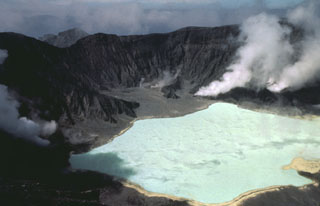Report on El Chichon (Mexico) — April 1983
Scientific Event Alert Network Bulletin, vol. 8, no. 4 (April 1983)
Managing Editor: Lindsay McClelland.
El Chichon (Mexico) Crater lake recedes rapidly
Please cite this report as:
Global Volcanism Program, 1983. Report on El Chichon (Mexico) (McClelland, L., ed.). Scientific Event Alert Network Bulletin, 8:4. Smithsonian Institution. https://doi.org/10.5479/si.GVP.SEAN198304-341120
El Chichon
Mexico
17.3602°N, 93.2297°W; summit elev. 1150 m
All times are local (unless otherwise noted)
UNAM geologists visited El Chichón 20-24 April. Fumarolic activity continued but there was no evidence of any recent ash ejection. Variations observed in the size of the fumarole plumes were thought to be caused by changes in temperature and humidity. Portable seismometers on the crater rim 21-23 April detected only two small events in 26 hours. The shore of the crater lake had receded 38 m (horizontally) since November 1982 (when the lake was roughly 500 m long, 300 m wide, and a maximum of 50 m deep), and about 30 m of the shrinkage had taken place since the previous measurements in January. Less than a week after geologists left the volcano major additional shrinkage of the lake was reported, and as of early May the lake occupied less than half the area it had covered 24 April. Pilots overflying the volcano were asked to report further changes in the lake, but no reports had been received as of 11 May. Data from a telemetering seismometer 16 km SSE of the volcano showed no change in seismicity through 4 May.
Geological Summary. El Chichón is a small trachyandesitic tuff cone and lava dome complex in an isolated part of the Chiapas region in SE México. Prior to 1982, this relatively unknown volcano was heavily forested and of no greater height than adjacent non-volcanic peaks. The largest dome, the former summit of the volcano, was constructed within a 1.6 x 2 km summit crater created about 220,000 years ago. Two other large craters are located on the SW and SE flanks; a lava dome fills the SW crater, and an older dome is located on the NW flank. More than ten large explosive eruptions have occurred since the mid-Holocene. The powerful 1982 explosive eruptions of high-sulfur, anhydrite-bearing magma destroyed the summit lava dome and were accompanied by pyroclastic flows and surges that devastated an area extending about 8 km around the volcano. The eruptions created a new 1-km-wide, 300-m-deep crater that now contains an acidic crater lake.
Information Contacts: S. de la Cruz-Reyna, UNAM, México.

